
Discusses the effect of social norms and cultural context on pro-environmental behaviors.
- Subject:
- Social Studies
- Material Type:
- Reading
- Provider:
- The Regents of the University of California
- Date Added:
- 01/25/2018

Discusses the effect of social norms and cultural context on pro-environmental behaviors.
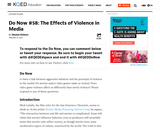
For this resource, students discuss the effects of violence in media and respond to questions on aggressive behavior and the portrayal of violence in the media.

This resource provides an explanation of egocentrism and development.

This research article explores facial feedback and emotions.

The 11th grade learning experience consists of 7 mostly month-long units aligned to the Common Core State Standards, with available course material for teachers and students easily accessible online. Over the course of the year there is a steady progression in text complexity levels, sophistication of writing tasks, speaking and listening activities, and increased opportunities for independent and collaborative work. Rubrics and student models accompany many writing assignments.Throughout the 11th grade year, in addition to the Common Read texts that the whole class reads together, students each select an Independent Reading book and engage with peers in group Book Talks. Students move from learning the class rituals and routines and genre features of argument writing in Unit 11.1 to learning about narrative and informational genres in Unit 11.2: The American Short Story. Teacher resources provide additional materials to support each unit.

In this unit, students will produce two major pieces of work. The first piece is an argument essay that grapples with one of the core questions of the unit: who are we, and who have we become because of the ways we connect? Students will read, annotate, and discuss several texts together as they consider the issues surrounding this question, and they will also research and annotate independently as they search for more evidence and perspectives to help deepen their ideas. They will also create a museum exhibit as part of a team. The exhibit project will help students identify what's worth preserving about their unique place in history.
PROJECT UNITS
This project unit continues to meet the English Language Arts standards as it also utilizes the learning principles established by the Partnership for 21st Century Skills. It is designed to support deep content knowledge and perseverance through long-term project planning and implementation. In addition, it will help students to recognize, develop, and apply the planning, teamwork, communication, and presentation skills they will use while presenting a final product to their class and/or the greater community. This real-world project-based activity will give students an opportunity to apply the skills they have been learning all year and will guide them to develop the motivation, knowledge, and skills they need in order to be college and career ready.
ACCOMPLISHMENTS
Students write an argument paper where they develop a claim about current culture as it has been influenced by digital connectivity.
Students participate in a group project to create a museum exhibit that captures a unique place, time, and relationship to technology. Students acknowledge the differing perspectives of each group member and use those perspectives to synthesize one cohesive visual argument together.
GUIDING QUESTIONS
These questions are a guide to stimulate thinking, discussion, and writing on the themes and ideas in the unit. For complete and thoughtful answers and for meaningful discussions, students must use evidence based on careful reading of the texts.
What does it mean to be digitally connected?
What are the implications of living in a world where everyone is digitally connected?
How does the availability of instant connectivity shape our relationships?
What does our Internet use reveal about people's needs as humans?
BENCHMARK ASSESSMENT: Cold Read
During this unit, on a day of your choosing, we recommend you administer a Cold Read to assess students’ reading comprehension. For this assessment, students read a text they have never seen before and then respond to multiple-choice and constructed-response questions. The assessment is not included in this course materials.

Today, you and your classmates will show what you have learned about narrative writing by taking a quick assessment. You will also read and compare two articles that offer a positive take on the ways young Digital Natives are using technology.In this lesson, students will take the third in a series of three Cold Write assessments in the narrative writing genre. The Benchmark Assessment (Cold Write) is an unassisted and unrevised piece of writing whose purpose is to provide a quick gauge of the student’s mastery of the characteristics of a given genre. Today’s Benchmark Assessment (Cold Write) measures and provides a benchmark of students’ mastery of narrative writing.Students will also read and compare two articles that offer a positive take on the ways young Digital Natives are using technology.
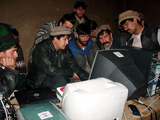
Lesson OverviewIn this lesson, you will learn about the Unit Accomplishments: an argument essay and a museum exhibit, both based on your personal understanding of technology's role in shaping our culture and the way we connect to each other.In this lesson, students will learn about the Unit Accomplishments: an argument essay and a museum exhibit, both based on their personal understanding of technology's role in shaping our culture and the way we connect to each other.

This resource outlines Erikson's psychosocial stages of development.
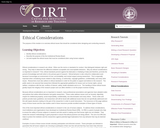
This resource introduces and discusses ethical issues that should be considered when designing and conducting a research project.
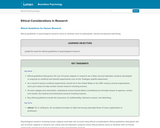
Provides information to justify the need for ethical guidelines in psychological research.
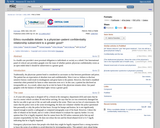
This research article discusses whether patient-physician confidentiality should be subervient to a greater good.

The resource discusses the major functions of ethics codes and why they are important in psychological research.
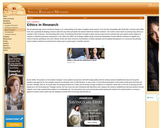
This resource explains the purpose of ethics in research.
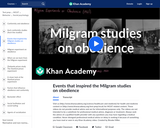
This video explains the Milgram studies on obedience.
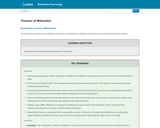
This resource summarizes the evolutionary perspective on motivation.

This video explains factors that influence obedience and conformity.
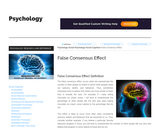
This article explains false consensus effect.

This resource explains Festinger's theory of cognitive dissonance.
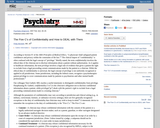
This research article discusses the exceptions to the duty of confidentiality for clinicians.